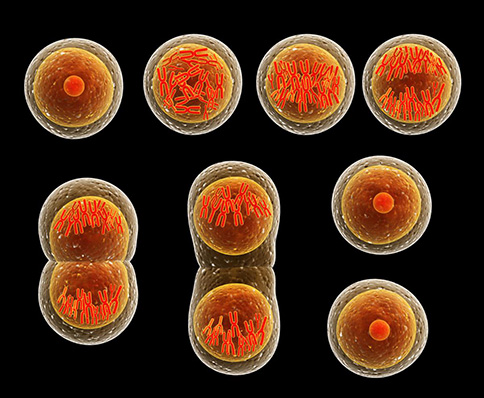
As a cell moves through the cell cycle, the shape of the DNA in the nucleus changes dramatically, from a ball of DNA during normal cell activities to distinct X-shaped chromosomes as the cell prepares to divide. This change in shape is important for the orderly passage of one copy of the DNA to each new cell. Before the cells begin to divide, the DNA compacts into the dense X-shaped chromosomes that are made up of consecutive DNA loops. How the compaction of loops occurs is not well understood. One of the goals of the 4D Nucleome program is to determine how the structure of DNA in the nucleus of a cell changes over time.
In a recent study in Science, a team led by 4DN-funded researchers Dr. Leonid Mirny and Dr. Job Dekker combined techniques that are used to determine where regions of the genome “touch” with imaging and modeling techniques at one-minute time intervals to investigate how DNA rearrangement occurs before cell division. Based on their results, they propose a model in which cells use a protein called “condensin” to drive the compaction of DNA. Condensin proteins create DNA loops by pushing DNA through their ring-like structures. In this model, condensin I creates wide loops in the DNA that are then split into smaller loops by condensin II. The loops twist around a condesin scaffold in a structure resembling a spiral staircase, creating a condensed helix of consecutive DNA loops that makes up the X-structure of the chromosomes and results in formation of compact units of DNA that can be easily divided between new cells. Understanding how the organization of DNA changes throughout the cell cycle is critical for determining how problems with cell cycle-associated DNA rearrangement (such as chromosome breakage) lead to human diseases such as cancer.
Reference
- A pathway for mitotic chromosome formation. Gibcus, JH, Samejima, K, Goloborodko, A, Samejima, I, Naumova, N, Nuebler, J, Kanemaki, MT, Xie, L, Paulson, JR, Earnshaw, WC, Mirny, LA, Dekker, J. Science. 2018 Jan 18. doi: 10.1126/science.aao6135.
In the News
- Packing a Genome, Step-by-Step, Howard Hughes Medical Institute
- How Cells Pack Tangled DNA Into Neat Chromosomes, Quanta Magazine


